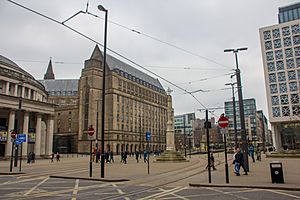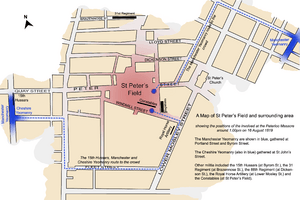St Peter's Square, Manchester facts for kids

St Peter's Square in January 2018
|
|
| Maintained by | City of Manchester |
|---|---|
| Location | Manchester, England, UK |
| Coordinates | 53°28′40″N 2°14′37″W / 53.47778°N 2.24361°W |
| Construction | |
| Completion | 1930s |
St Peter's Square is a busy public square in the heart of Manchester city centre, England. It's a place where many important buildings and monuments are located. You can find the Manchester Central Library, the Midland Hotel, and the Manchester Town Hall Extension nearby.
The square is also home to the Manchester Cenotaph, a special memorial. You can see a statue of Emmeline Pankhurst, a famous leader for women's rights. The St Peter's Square Metrolink tram stop is right here, making it easy to get around the city. There's even a peaceful area called the Peace Garden.
Between 2010 and 2017, St Peter's Square got a big makeover. This included fixing up the Central Library and moving the Cenotaph. A new, bigger tram stop was built, and two new office buildings, One St Peter's Square and Two St Peter's Square, were added.
Contents
History of St Peter's Square
The area where St Peter's Square now stands was once known as St Peter's Field. In 1819, a very important and sad event happened here called the Peterloo Massacre. This was when a large group of people gathered peacefully to ask for changes in how the country was run, but the military attacked them.
The square gets its name from St Peter's Church. This church was built between 1788 and 1794. It was known for its beautiful music. The church was taken down in 1907. In its place, the Cenotaph was built in 1924. A stone cross from 1908 also remembers the old church. Every year, people gather here for Remembrance Day to honor those who served in wars.
In the 1930s, the square was redesigned. This happened when the Central Library and the Town Hall Extension were built. These buildings were finished between 1930 and 1934.
The Metrolink Tram Stop
Plans for a train station in St Peter's Square were made a long time ago, in the 1970s. These plans were for an underground station. Later, when ideas for a street-level tram system came up, the idea of a stop in the square returned. This idea became real when the Metrolink tram system opened in 1992.
Peace Garden: A Quiet Spot
The Manchester Peace Garden is a calm place in the square. It's located where some old Victorian buildings used to be. One of these was the Mechanics' Institute, Manchester. In the garden, you can see a bronze statue called Adrift.
Monuments and Statues
The Manchester Cenotaph
The Manchester Cenotaph is a special war memorial. It was designed by Sir Edwin Lutyens. It looks a lot like the Cenotaph in Whitehall, London. It was officially opened in 1924. Since then, the yearly Remembrance Day ceremonies have been held here. Part of the garden wall was moved to make space for the tram station.
Redevelopment of the Square
In 2013, the Manchester City Council approved plans to make the square even better. This included making the Metrolink tram stop bigger, with four platforms. This work happened at the same time as the building of One St Peter's Square and the renovation of Manchester Central Library.
The project cost a lot of money, some of it from public funds. It involved moving the Cenotaph and the Peace Gardens. An older building was also taken down to create space for new offices. Some people thought the plans were too focused on businesses rather than the public.
However, the developers and English Heritage, a group that protects historic places, said they were happy with the plans. They believed the changes would help St Peter's Square become the grand public space it was always meant to be.
Images for kids







